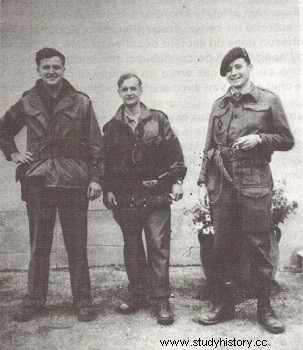
Jedburgh is an operation carried out by the Allied forces during the Second World War, which aimed to coordinate the action of the maquis with the general plans of the Supreme Headquarters Allied Expeditionary Force and to equip the resistance fighters, in France and the Netherlands , with a view to immobilizing the Axis forces far from the coast at the time of the Normandy landings.
Men from the British Special Operations Executive, the American Office of Strategic Services, the Central Intelligence and Action Bureau of Free France as well as soldiers from the various armies of the countries concerned (France and the Netherlands) were parachuted, in teams of three, behind the German lines, with a view to conducting — in uniform — sabotage and guerrilla actions against the Germans, and to direct the action of the Resistance. These commandosJedburghs are the precursors of contemporary special forces.
Of 279 members of the Jedburgh teams, twenty-one died in operation.
Origin of the name
The first code name of the operation is Jumper. In July 1942, the operation was renamed Jedburgh. On the reasons for the choice of this name, historians point out two hypotheses:
Jedburgh would refer to the Scottish town of that name, located in the Scottish Borders region, south of Edinburgh, where the Scots carried out guerrilla operations against the English invaders in the 12th century. This hypothesis is the most commonly stated.
Jedburgh would refer to a village in South Africa where the British, during the Second Boer War (1899-1902) would have secretly infiltrated troops behind the lines enemies. This hypothesis is the one given by Fabrizio Calvi, based on interviews with Albert de Schonen and Paul Aussaresses. In his memoirs (Pour la France -Services Spéciales 1942-1954, p. 107), Aussaresses cites only the first hypothesis, however.
Men training
The Jedburghs teams were trained from April to December 1944 at the Milton Hall camp (Jedburgh Training School, code name Military Establishment 25 or ME 65), in the county of Cambridge (England).
This camp is led by Lieutenant-Colonel of Artillery George Richard Musgrave. This officer fought in Somaliland in April-May 1941 under the orders of Colonel Orde Charles Wingate. In 1945 he led the ME 25 camp of SOE Force 136 in Southeast Asia, located in Colombo (Ceylon, now Sri Lanka).
They receive intensive training at Henley-on-Thames and undergo psychological testing, extensive physical training, and shooting and combat training.
Description of the operation
The teams parachuted behind enemy lines operate in uniform with an officer from the host countries (French, Dutch). They are parachuted into areas taken over by the Special Operations Executive, more than sixty kilometers behind the lines to act and have communications with the staffs or with London.
Most often, the teams consist of two officers and a radio operator.
The radio operator ensures contact between the maquis and central London, on the one hand, and friendly invading regular troops approaching the maquis areas, on the other. The only contact of the radios with the outside is the Charles Station whose operators are trained in frequency changes and making contact and calls. Two daily contacts are permitted; contact hours are fixed, frequencies may vary. Charles Station liaises with 64 Jedburgh teams and 24 regular mobile stations north of the Loire in July 1944.
Between June and September 1944, 279 Jedburghs – divided into 94 teams (teams) of 3 (the most common format) jumped over France and the Netherlands from bases in England and North Africa. Among them, there are 114 French, often from Free France. Paul Aussaresses, Jean Sassi and Jean Larrieu were Jed's.
We count:
66 American non-commissioned officers from the Office of Strategic Services;
14 French radios.
Efficiency of the operation
In Normandy
The Jedburgh operation coupled with the actions of the SAS made it possible to disorganise, block the German response with the help of the resistance.
In Provence
The Jedburghs allowed the liberation of towns such as Guillestre or Briançon, allowing the Allied forces landed in Provence to rush to the east by taking the German army in a vice, gaining weeks on the liberation of the regions encountered.
Continued
After their action in France or the Netherlands, some members of the Jedburgh teams carry out similar missions in Norway, Italy, Burma, Malaysia, Borneo, Indonesia, China and Indochina, Force 136.
Personalities who have been members of Jedburgh teams
Jean Sassi, alias Nicole (BCRA), alias Latimer (SFHQ), Chloroform team, second lieutenant
Paul Aussaresses, alias Soual (BCRA), alias Bazin (SFHQ), Chrsyler team, captain
